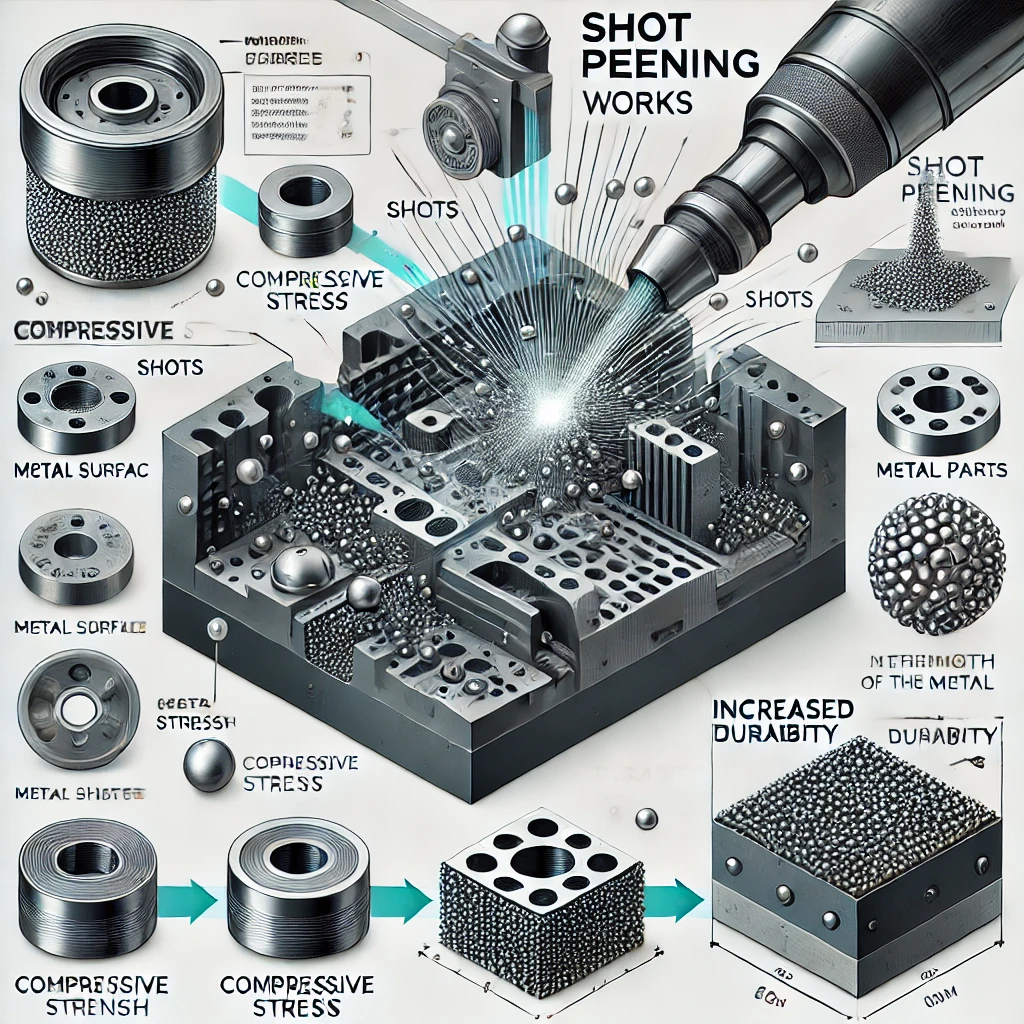Shot peening is a surface treatment process used to improve the strength and durability of metal parts by inducing beneficial residual compressive stresses. It is commonly used in industries such as aerospace, automotive, and manufacturing to enhance the fatigue resistance of components like gears, springs, shafts, and turbine blades.

Here’s a breakdown of how the shot peening process works, its benefits, and why it’s an essential method for extending the life of metal parts.
What is Shot Peening?
Shot peening involves bombarding the surface of a metal part with small spherical media, commonly referred to as shot (typically made from steel, glass, or ceramic). These shots hit the surface at high velocity, creating tiny indentations. Each impact causes the surface layer of the metal to deform slightly and compress. The accumulation of these compressed areas creates a residual compressive stress layer, which strengthens the material and improves its resistance to fatigue, cracking, and stress corrosion.
How the Shot Peening Process Works
1. Impact and Deformation
In shot peening, small spherical media (the “shots”) are propelled at the surface of the metal part at high speeds using air pressure, centrifugal force, or a mechanical device. The impact of each shot causes plastic deformation, meaning the material is compressed and slightly reshaped.
2. Residual Compressive Stress
As the surface of the metal is repeatedly impacted, small dimples are formed. Beneath these dimples, the metal becomes compressed. This compression causes residual compressive stress to build up just below the surface. This stress helps counteract any tensile stresses that might occur during the part’s normal operation, which can lead to cracks or fatigue.
3. Stress Redistribution
The residual compressive stresses from shot peening push the internal tensile stresses deeper into the material, reducing the likelihood of cracks forming on the surface. By strengthening the surface layer, shot peening significantly enhances the fatigue life of the part, preventing premature failure.
Key Variables in Shot Peening
Several factors affect the outcome of the shot peening process, including:
1. Shot Material
The media used in shot peening can vary based on the application:
- Steel shot: The most common, used for heavy-duty applications.
- Glass beads: Often used for less aggressive peening and when a cleaner, smoother finish is desired.
- Ceramic shot: Provides a hard, wear-resistant finish, often used for delicate or precision components.
2. Shot Size
The size of the shot determines the intensity of the peening process. Larger shots create deeper indentations and compressive stresses, while smaller shots create finer, more controlled results. The appropriate shot size depends on the specific requirements of the part being treated.
3. Shot Velocity
The velocity of the shot impacts the energy of the peening process. Higher velocity results in more aggressive peening and deeper compressive stress layers. The velocity is typically controlled by the type of equipment used, such as air or wheel-blast systems.
4. Coverage
Coverage refers to the extent of the surface area that is peened. To ensure full effectiveness, the entire surface of the part must be covered evenly, which requires careful monitoring and control of the process.
Benefits of Shot Peening
1. Increased Fatigue Life
Shot peening helps improve the fatigue resistance of metal parts by introducing compressive stresses that counteract tensile stresses, which can cause cracks or fatigue failures. This process is particularly valuable for parts subjected to cyclic loading, such as springs, gears, and turbine blades.
2. Improved Stress Corrosion Resistance
Parts treated with shot peening are more resistant to stress corrosion cracking because the compressive stresses at the surface prevent crack formation and propagation. This is especially important in environments where metals are exposed to corrosive elements.
3. Enhanced Surface Durability
Shot peening can also increase the surface hardness of the material, making it more resistant to abrasion and wear. This is particularly useful for parts like gears and shafts, which are subject to heavy wear during operation.
4. Reduced Surface Defects
The peening process can help smooth out surface defects, which reduces the likelihood of cracks forming. The process also improves the overall finish and strength of the material, making it more reliable in high-stress environments.
Common Applications of Shot Peening
Shot peening is used across a wide range of industries to improve the performance and lifespan of metal components. Some common applications include:
- Automotive: Gears, axles, suspension springs, and connecting rods are peened to enhance durability and resist fatigue.
- Aerospace: Critical components like turbine blades, landing gear, and engine parts are shot-peened to withstand high stresses.
- Manufacturing: Components such as tooling, molds, and dies are shot-peened to prevent cracking and improve wear resistance.
- Oil and Gas: Peening is used to strengthen pipelines, valves, and drilling equipment that are subject to harsh conditions.
Conclusion: Why Shot Peening is Essential
Shot peening is a crucial process for extending the life and improving the performance of metal components that experience high levels of stress, fatigue, and wear. By inducing beneficial compressive stresses, it reduces the risk of cracking and fatigue failures, making it an indispensable technique in industries like aerospace, automotive, and manufacturing.
Whether you’re producing parts that need to withstand high-pressure conditions or just looking to improve the longevity of critical components, shot peening is a proven and reliable solution.
